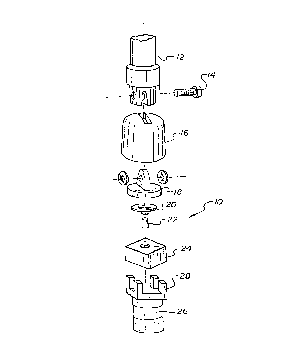Une partie des informations de ce site Web a été fournie par des sources externes. Le gouvernement du Canada n'assume aucune responsabilité concernant la précision, l'actualité ou la fiabilité des informations fournies par les sources externes. Les utilisateurs qui désirent employer cette information devraient consulter directement la source des informations. Le contenu fourni par les sources externes n'est pas assujetti aux exigences sur les langues officielles, la protection des renseignements personnels et l'accessibilité.
L'apparition de différences dans le texte et l'image des Revendications et de l'Abrégé dépend du moment auquel le document est publié. Les textes des Revendications et de l'Abrégé sont affichés :
| (12) Brevet: | (11) CA 2247418 |
|---|---|
| (54) Titre français: | ANTENNE POUR DISPOSITIF DE TELECOMMUNICATIONS PAR VOIE HERTZIENNE |
| (54) Titre anglais: | ANTENNA FOR A RADIO TELECOMMUNICATIONS DEVICE |
| Statut: | Durée expirée - au-delà du délai suivant l'octroi |
| (51) Classification internationale des brevets (CIB): |
|
|---|---|
| (72) Inventeurs : |
|
| (73) Titulaires : |
|
| (71) Demandeurs : |
|
| (74) Agent: | MARKS & CLERK |
| (74) Co-agent: | |
| (45) Délivré: | 2001-01-09 |
| (86) Date de dépôt PCT: | 1997-03-04 |
| (87) Mise à la disponibilité du public: | 1997-09-12 |
| Requête d'examen: | 1998-08-27 |
| Licence disponible: | S.O. |
| Cédé au domaine public: | S.O. |
| (25) Langue des documents déposés: | Anglais |
| Traité de coopération en matière de brevets (PCT): | Oui |
|---|---|
| (86) Numéro de la demande PCT: | PCT/CA1997/000155 |
| (87) Numéro de publication internationale PCT: | WO 1997033338 |
| (85) Entrée nationale: | 1998-08-27 |
| (30) Données de priorité de la demande: | ||||||
|---|---|---|---|---|---|---|
|
La présente invention concerne une antenne pour télécommunications par voie hertzienne constituée d'une longueur d'antenne télescopique permettant sensiblement de recevoir un signal électromagnétique. La longueur télescopique est raccordée au mât d'antenne de façon à conduire le signal électromagnétique. Un diélectrique intermédiaire et un inducteur sont en continuité galvanique avec le mât d'antenne, un connecteur HF étant en continuité galvanique avec le diélectrique intermédiaire, à l'opposé du mât d'antenne, de façon à constituer un condensateur. Le connecteur HF est également en continuité galvanique avec l'inducteur, ce qui fait que le condensateur forme avec l'inducteur un circuit LC dont les valeurs sont sélectionnées de façon à obtenir une correspondance d'impédances définie avec le reste de l'antenne.
A radio telecommunications antenna includes a telescoping antenna portion for
substantially receiving an electromagnetic signal. The telescoping portion is
attached by an antenna mast for conducting the electromagnetic signal. A
dielectric spacer and an inductor are in electrical contact with the antenna
mast. An RF connector is in electrical contact with the dielectric spacer,
opposite the antenna mast, so as to form a capacitor. The RF connector is also
in electrical contact with the inductor so that the capacitor and the inductor
form an LC circuit with values selected to provide a predetermined impedance
match with the remainder of the antenna.
Note : Les revendications sont présentées dans la langue officielle dans laquelle elles ont été soumises.
Note : Les descriptions sont présentées dans la langue officielle dans laquelle elles ont été soumises.

2024-08-01 : Dans le cadre de la transition vers les Brevets de nouvelle génération (BNG), la base de données sur les brevets canadiens (BDBC) contient désormais un Historique d'événement plus détaillé, qui reproduit le Journal des événements de notre nouvelle solution interne.
Veuillez noter que les événements débutant par « Inactive : » se réfèrent à des événements qui ne sont plus utilisés dans notre nouvelle solution interne.
Pour une meilleure compréhension de l'état de la demande ou brevet qui figure sur cette page, la rubrique Mise en garde , et les descriptions de Brevet , Historique d'événement , Taxes périodiques et Historique des paiements devraient être consultées.
| Description | Date |
|---|---|
| Inactive : Périmé (brevet - nouvelle loi) | 2017-03-04 |
| Accordé par délivrance | 2001-01-09 |
| Inactive : Page couverture publiée | 2001-01-08 |
| Inactive : Taxe finale reçue | 2000-10-02 |
| Préoctroi | 2000-10-02 |
| Un avis d'acceptation est envoyé | 2000-05-05 |
| Lettre envoyée | 2000-05-05 |
| Un avis d'acceptation est envoyé | 2000-05-05 |
| Inactive : Approuvée aux fins d'acceptation (AFA) | 2000-04-11 |
| Inactive : CIB attribuée | 1998-11-18 |
| Inactive : CIB attribuée | 1998-11-18 |
| Inactive : CIB en 1re position | 1998-11-18 |
| Inactive : CIB attribuée | 1998-11-18 |
| Symbole de classement modifié | 1998-11-18 |
| Inactive : Inventeur supprimé | 1998-10-27 |
| Inactive : Acc. récept. de l'entrée phase nat. - RE | 1998-10-27 |
| Inactive : Inventeur supprimé | 1998-10-27 |
| Inactive : Inventeur supprimé | 1998-10-27 |
| Inactive : Inventeur supprimé | 1998-10-27 |
| Inactive : Inventeur supprimé | 1998-10-27 |
| Demande reçue - PCT | 1998-10-26 |
| Exigences pour une requête d'examen - jugée conforme | 1998-08-27 |
| Toutes les exigences pour l'examen - jugée conforme | 1998-08-27 |
| Demande publiée (accessible au public) | 1997-09-12 |
Il n'y a pas d'historique d'abandonnement
Le dernier paiement a été reçu le 2000-02-23
Avis : Si le paiement en totalité n'a pas été reçu au plus tard à la date indiquée, une taxe supplémentaire peut être imposée, soit une des taxes suivantes :
Veuillez vous référer à la page web des taxes sur les brevets de l'OPIC pour voir tous les montants actuels des taxes.
Les titulaires actuels et antérieures au dossier sont affichés en ordre alphabétique.
| Titulaires actuels au dossier |
|---|
| RESEARCH IN MOTION LIMITED |
| Titulaires antérieures au dossier |
|---|
| LIZHONG ZHU |
| PERRY JARMUSZEWSKI |
| PETER J. EDMONSON |
| STEVEN CARKNER |
| YIHONG QI |